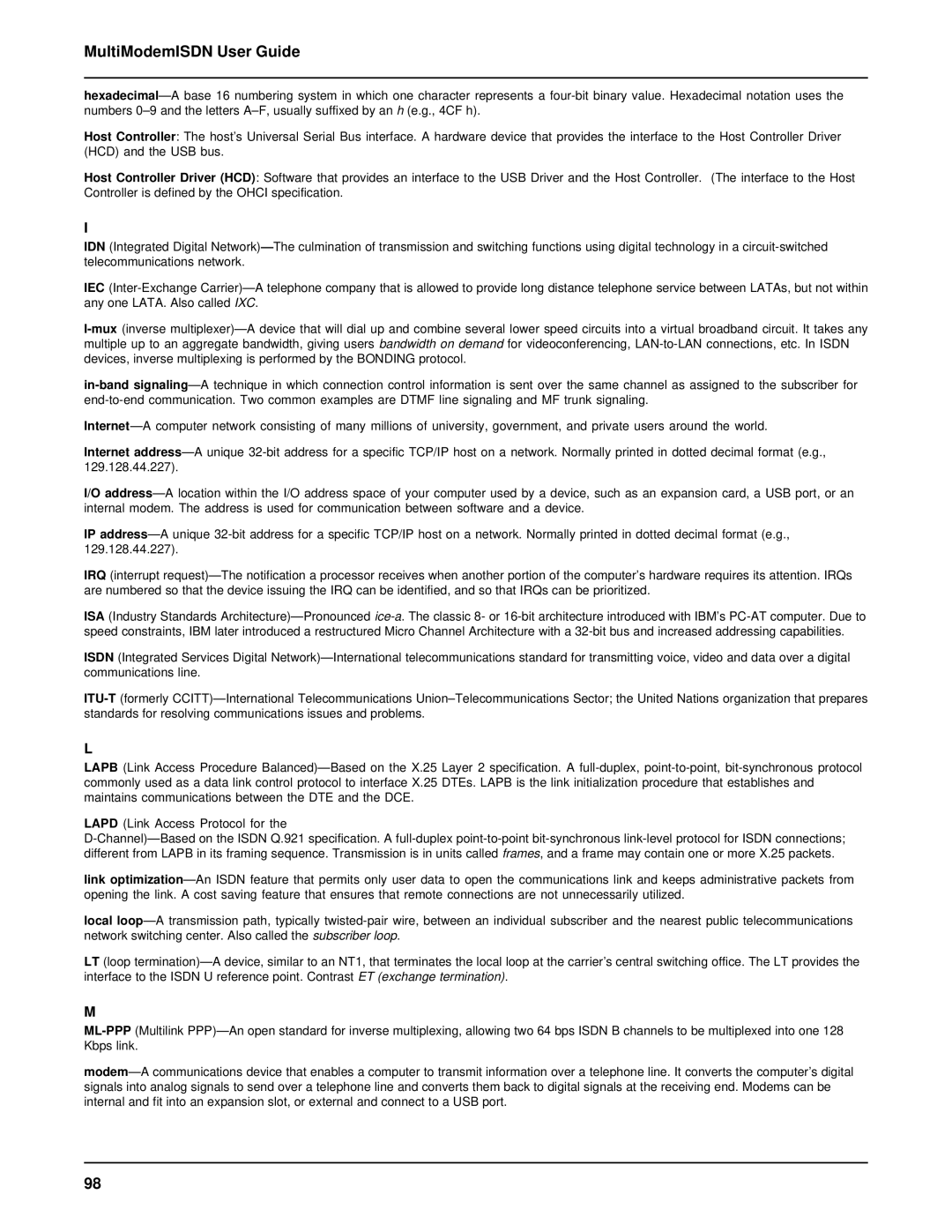MultiModemISDN User Guide
hexadecimal— A base 16 numbering system in which one character represents a four-bit binary value. Hexadecimal notation uses the numbers 0–9 and the letters A–F, usually suffixed by an h (e.g., 4CF h).
Host Controller: The host’s Universal Serial Bus interface. A hardware device that provides the interface to the Host Controller Driver (HCD) and the USB bus.
Host Controller Driver (HCD): Software that provides an interface to the USB Driver and the Host Controller. (The interface to the Host Controller is defined by the OHCI specification.
I
IDN (Integrated Digital Network)—The culmination of transmission and switching functions using digital technology in a circuit-switched telecommunications network.
IEC (Inter-Exchange Carrier)— A telephone company that is allowed to provide long distance telephone service between LATAs, but not within any one LATA. Also called IXC.
I-mux(inverse multiplexer)— A device that will dial up and combine several lower speed circuits into a virtual broadband circuit. It takes any multiple up to an aggregate bandwidth, giving users bandwidth on demand for videoconferencing, LAN-to-LAN connections, etc. In ISDN devices, inverse multiplexing is performed by the BONDING protocol.
in-band signaling— A technique in which connection control information is sent over the same channel as assigned to the subscriber for end-to-end communication. Two common examples are DTMF line signaling and MF trunk signaling.
Internet— A computer network consisting of many millions of university, government, and private users around the world.
Internet address— A unique 32-bit address for a specific TCP/IP host on a network. Normally printed in dotted decimal format (e.g., 129.128.44.227).
I/O address— A location within the I/O address space of your computer used by a device, such as an expansion card, a USB port, or an internal modem. The address is used for communication between software and a device.
IP address— A unique 32-bit address for a specific TCP/IP host on a network. Normally printed in dotted decimal format (e.g., 129.128.44.227).
IRQ (interrupt request)— The notification a processor receives when another portion of the computer’s hardware requires its attention. IRQs are numbered so that the device issuing the IRQ can be identified, and so that IRQs can be prioritized.
ISA (Industry Standards Architecture)— Pronounced ice-a. The classic 8- or 16-bit architecture introduced with IBM’s PC-AT computer. Due to speed constraints, IBM later introduced a restructured Micro Channel Architecture with a 32-bit bus and increased addressing capabilities.
ISDN (Integrated Services Digital Network)— International telecommunications standard for transmitting voice, video and data over a digital communications line.
ITU-T(formerly CCITT)— International Telecommunications Union–Telecommunications Sector; the United Nations organization that prepares standards for resolving communications issues and problems.
L
LAPB (Link Access Procedure Balanced)— Based on the X.25 Layer 2 specification. A full-duplex, point-to-point, bit-synchronous protocol commonly used as a data link control protocol to interface X.25 DTEs. LAPB is the link initialization procedure that establishes and maintains communications between the DTE and the DCE.
LAPD (Link Access Protocol for the
D-Channel)— Based on the ISDN Q.921 specification. A full-duplex point-to-point bit-synchronous link-level protocol for ISDN connections; different from LAPB in its framing sequence. Transmission is in units called frames, and a frame may contain one or more X.25 packets.
link optimization— An ISDN feature that permits only user data to open the communications link and keeps administrative packets from opening the link. A cost saving feature that ensures that remote connections are not unnecessarily utilized.
local loop— A transmission path, typically twisted-pair wire, between an individual subscriber and the nearest public telecommunications network switching center. Also called the subscriber loop.
LT (loop termination)— A device, similar to an NT1, that terminates the local loop at the carrier’s central switching office. The LT provides the interface to the ISDN U reference point. Contrast ET (exchange termination).
M
ML-PPP(Multilink PPP)— An open standard for inverse multiplexing, allowing two 64 bps ISDN B channels to be multiplexed into one 128 Kbps link.
modem— A communications device that enables a computer to transmit information over a telephone line. It converts the computer’s digital signals into analog signals to send over a telephone line and converts them back to digital signals at the receiving end. Modems can be internal and fit into an expansion slot, or external and connect to a USB port.

